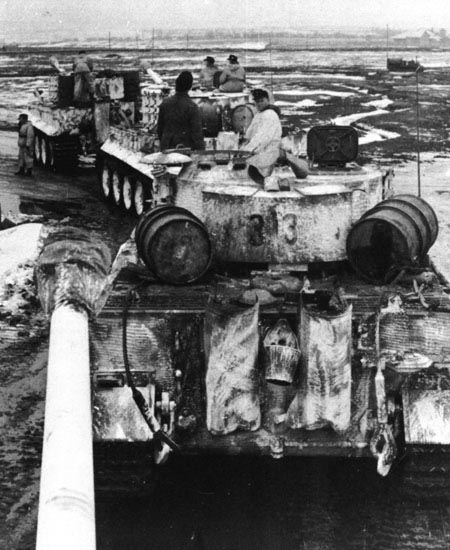Leaflet 47a/30
Official Use Only!
Leaflet for the Employment of heavy
tank-battalion "Tiger"
20.5.43
Inspector of tank-forces
The "Leaflet for the employment
of heavy tank-battalion Tiger" is hereby permitted
Guderian
This is a secret document after §3
Reichs-Straf-Gesetz-buch (as of 24th April 1938). Misuse
will be punished afterthat regulations, until other penal
law fits in.
A. Character, tasks and formation
Weapon and armor in combination with high mobility
render the Tiger to the most acute weapon of the
tank-forces. The Tiger-battalion is therefore a mighty
center-weapon in the hands of the commanding officer. Its
power lies in the closed, reckless-lead attack. Every
split-up lowers its efficency. Thorough preparation of
engagement at decisive point guarantees thesuccess.
Tiger-battalions are army forces. They are placed
under the command other tank-formations, right in the
center of engagements to enforce the decision. They must
not be used up at early time in secondary actions. They
are especially suited for the battle against heavy enemy
tank-forces and they have to seek this fight. The
destruction of enemy tanks makes up the assumption for
the own lighter tanks to successfully fulfill their
missions.
It is prohibited to assign the Tiger to such tasks,
which can be solved by lighter tanks or assault guns,
likewise it must not be used for recon- and
securing-tasks.
The Tiger-battalion is arranged in:
Staff of battalion
Staff-company with: Intelligence platoon, armored
recon-platoon (SPW), recon platoon, engineer platoon,
air-defense-platoon (and a squad for administration and
supply)
3 heavy tank-companies
1 Tank-workshop-company
B. Employment
 |
As offroad trasports lacked to the German
Army, many units had to carry as much supplies as
possible when travelling in difficult terrain.
|
In employment of a Tiger-battalion
generally the same basis for other tank-forces applies.
From the peculiarity of the Tiger result the following
special forms:
I. March
1. As center-weapons the Tiger-battalions are to be
placed as front units in the order of march.
2. The pathways are to be chosen really carefully by
the commanders.
3. Responsible for careful recon is the
battalion-commander. Recon and restoration of bridges,
forts and path-ends is essentially. Accurate map-studies,
the evaluation of present air-views and the well-timed
deploy of the recon- and engineer-platoons is hereby
necessary.
4. On longer marches a coupling of Tiger-units with
other tank-detachments is interdicted due to technical
motives.
5. During the traversing of bridges with doubtful
carrying capacity lighter tanks with their immediate
battle-supplies are to be preferred to the Tiger.
6. Average marching speed:
Day: 10 - 15 km/h
Night: 7 - 10 km/h
7. Frequent technical stops are essential. After the
first 5 km and after this every 10-15 km a technical stop
is to be commanded.
8. Roads with heavy vault and strong pavements are to
be avoided.
II. Preparation
1. For the care of the surprise momentum a sufficent
distance from enemy forces for the the preparation room
due to the loud roaring of the engine is to be paid
attention to. Wind direction and wind velocity are also
hereby to be cared of.
2. After drive-in into the preparation-room the
striking, wide and deep traces of the Tiger are to be
cloaked, in order to hide the presence of heavy tanks to
enemy intelligence.
III. Battle
1. For battle-recon the armored recon-platoon is to
be deployed by the commander. In case of need lighter
tanks of the accompanying tank-formations are to be
committed moreover.
2. In the battle the Tiger is to be used at that
place, where the decisive success shall be enforced. The
battalion is to be deployed at first engagement in the
center. Every weapon supports the battalion on
fulfillment of their tasks. Well-timed usage of
mine-sweeping units and engineers or tight cooperation
with these units for spotting and clearing of mines and
obstacles is necessary.
3. In battle with enemy tanks quick reaction and
strict leadership is the premise for success. With
rapidedly changing battle tactics the enemy is to be
tricked and to be confused.
Generally the following tactics have proven:
a) Enemy tanks are to be pinned frontally by the fire
of lighter tank units. Then they are to be round by the
Tigers and to be attacked from the flanks or to the rear,
while the other tanks support the Tiger-attack by
constant frontal fire.
b) The Tigers obtain by fighting a frontal or
flanking swiftly-driven attack and their firepower the
superiority over the enemy-tanks, where they are
supported by the the fire of other tank-units.
4. In the battle for villages the Tiger is not to be
used for streetfighting in respect to its large blind
spot and the wide-overlapping gun. Accordingly the same
applies for battles in the woods.
5. The Tiger is well suited for pursuits. The
provisions for this are well-timed recon and early start
(Fuel and ammunition).
IV. Restoration units
Every possible resting time has to be granted to the
Tiger-detachment for technical restoration. After longer
operations sufficent time for the restoration of full
battle strength and careful maintenance and service has
to be given. The restoration unit has to be supported
extensively by all quarters and command authorities.
|
